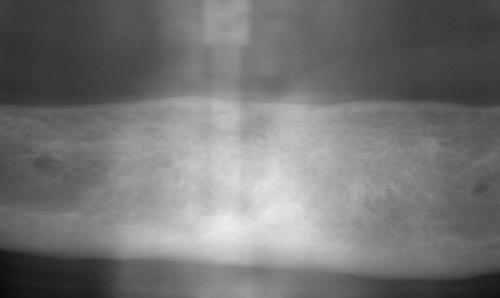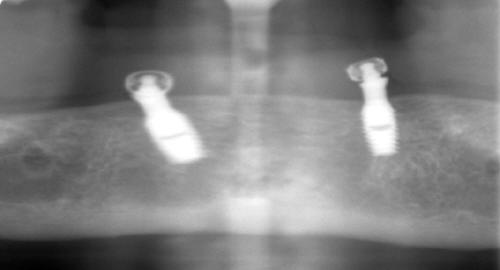|
|
||
| Fig.1 | Fig.2 | |
 |
 |
|
| Fig.3 | Fig.4 | Fig.5 |
Dental Education Lecture: Loose Denture
|
|
||
| Fig.1 | Fig.2 | |
 |
 |
|
| Fig.3 | Fig.4 | Fig.5 |
In the last two lectures, partial and complete dentures are mentioned. Both of them are removable. You can take them in and out for cleaning. Removable dentures have a common shortcoming. They are relatively loose when you chew. The more teeth you lose, the more unstable the denture is. Looseness is less when one or more implants are added.
Mrs. Smith has lost all of lower teeth (Fig.1). The jaw bone is small. The bottom complete denture is so loose that she would rather eat without it. She has the denture re-made several times without much improvement. Although she has diabetes, she decides to let us place two implants in her lower jaw for denture stability (Fig.2 and 4). Fig.3 and 4 are before and after X-ray. What are exposed outside the gums are called abutments (Fig.2). On the top of each abutment is a cap-like device called attachment (Fig.3). The latter is buried into the underneath surface of the existing denture. Abutment and attachment lock into each other. She is still able to take the denture in and out for cleaning. Once she seats the denture, it is much more stable. After a little while, she can eat peanuts. Before implant placement, what embarrasses her most is that at dinner table she could not eat what a friendly host serves. She has no gut to tell anybody that she does not have teeth to enjoy the meal. To understand how implants and their apparatuses help denture stability, please read this.
These days, two-implant retained lower complete denture is a standard care. Anything less is sort of uncivilized. If we add two or more implants to the case mentioned above, the denture is more stable, almost rock solid. Our upper jaw is relatively large. Well-fabricated upper complete denture can provide sufficient stability. When the upper jaw becomes too small after decades of denture wearing, we need at least four implants for denture holding. Our upper jaw bone is not as solid as the lower one. We need more implants for force distribution. For implant terminology such as abutment, we need another lecture. See you next time.
Xin Wei, DDS, PhD, MS 1st edition 02/14/2009, last revision 09/28/2012